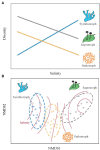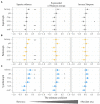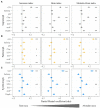Rare Taxa Drive the Response of Soil Fungal Guilds to Soil Salinization in the Taklamakan Desert
- PMID: 35677905
- PMCID: PMC9168468
- DOI: 10.3389/fmicb.2022.862245
Rare Taxa Drive the Response of Soil Fungal Guilds to Soil Salinization in the Taklamakan Desert
Abstract
Salinization poses great threats to soil fungal communities that would cause the losses of ecosystems services. Soil fungal communities are composed of different functional guilds such as saprotrophic, symbiotrophic, and pathotrophic fungi, and each guild includes many rare taxa and a few abundant taxa. Despite of low abundance, rare taxa may be crucial in determining the responses of entire soil fungal communities to salinization. However, it remains poorly understood how rare taxa mediate the impacts of soil salinization on soil fungal community structure. Here, we took advantage of a salinity gradient in a desert ecosystem ranging from 0.60 to 31.09 g kg-1 that was created by a 12-year saline-water irrigation and assessed how the rare vs. abundant taxa of soil saprotrophic, symbiotrophic, and pathotrophic fungi respond to soil salinization through changes in the community biodiversity and composition. We found that the rare taxa of soil saprotrophic, symbiotrophic, and pathographic fungi were more sensitive to changes in soil salinity compared to the abundant taxa. In addition, the community composition of rare taxa of the saprotrophic and pathotrophic fungi not the symbiotrophic fungi was positively associated with soil salinity change. However, the symbiotrophic fungi showed greater variations in the species richness along the salinity gradient. These findings highlight the importance to differentiate rare taxa in predicting how the biodiversity and functional groups of soil fungal communities respond to soil salinization.
Keywords: biodiversity; desert; functional guilds; rare biosphere; saprotrophic fungi; soil salinization; symbiotrophic fungi.
Copyright © 2022 Lin, Jing, Lucas-Borja, Shen, Wang and Feng.
Conflict of interest statement
The authors declare that the research was conducted in the absence of any commercial or financial relationships that could be construed as a potential conflict of interest.
Figures





Similar articles
-
The influence of soil salinization, induced by the backwater effect of the Yellow River, on microbial community dynamics and ecosystem functioning in arid regions.Environ Res. 2024 Dec 1;262(Pt 1):119854. doi: 10.1016/j.envres.2024.119854. Epub 2024 Aug 27. Environ Res. 2024. PMID: 39197488
-
[Structure and Function of Soil Fungal Community in Rotation Fallow Farmland in Alluvial Plain of Lower Yellow River].Huan Jing Ke Xue. 2023 Jan 8;44(1):482-493. doi: 10.13227/j.hjkx.202203233. Huan Jing Ke Xue. 2023. PMID: 36635836 Chinese.
-
Fungal guilds and soil functionality respond to tree community traits rather than to tree diversity in European forests.Mol Ecol. 2021 Jan;30(2):572-591. doi: 10.1111/mec.15749. Epub 2020 Dec 14. Mol Ecol. 2021. PMID: 33226697
-
Functional and ecological consequences of saprotrophic fungus-grazer interactions.ISME J. 2012 Nov;6(11):1992-2001. doi: 10.1038/ismej.2012.53. Epub 2012 Jun 21. ISME J. 2012. PMID: 22717883 Free PMC article. Review.
-
Global review reveals how disparate study motivations, analytical designs, and focal ions limit understanding of salinization effects on freshwater animals.Sci Total Environ. 2023 Sep 20;892:164061. doi: 10.1016/j.scitotenv.2023.164061. Epub 2023 May 27. Sci Total Environ. 2023. PMID: 37247728 Review.
Cited by
-
Metabolites Discovery from Streptomyces xanthus: Exploring the Potential of Desert Microorganisms.Biology (Basel). 2025 Feb 6;14(2):164. doi: 10.3390/biology14020164. Biology (Basel). 2025. PMID: 40001932 Free PMC article.
-
Altitudinal Variation Influences Soil Fungal Community Composition and Diversity in Alpine-Gorge Region on the Eastern Qinghai-Tibetan Plateau.J Fungi (Basel). 2022 Jul 30;8(8):807. doi: 10.3390/jof8080807. J Fungi (Basel). 2022. PMID: 36012795 Free PMC article.
-
Exploring the Diversity and Ecological Dynamics of Palm Leaf Spotting Fungi-A Case Study on Ornamental Palms in Portugal.J Fungi (Basel). 2025 Jan 7;11(1):43. doi: 10.3390/jof11010043. J Fungi (Basel). 2025. PMID: 39852462 Free PMC article.
-
Rare taxa mediate microbial carbon and nutrient limitation in the rhizosphere and bulk soil under sugarcane-peanut intercropping systems.Front Microbiol. 2024 May 30;15:1403338. doi: 10.3389/fmicb.2024.1403338. eCollection 2024. Front Microbiol. 2024. PMID: 38873152 Free PMC article.
-
Diversity and functional traits of indigenous soil microbial flora associated with salinity and heavy metal concentrations in agricultural fields within the Indus Basin region, Pakistan.Front Microbiol. 2022 Nov 7;13:1020175. doi: 10.3389/fmicb.2022.1020175. eCollection 2022. Front Microbiol. 2022. PMID: 36419426 Free PMC article.
References
-
- Akyol T., Sato S., Turkan I. (2020). Deploying root microbiome of halophytes to improve salinity tolerance of crops. Plant Biotechnol. Rep. 14, 143–150. doi: 10.1007/s11816-020-00594-w - DOI
-
- Balbuena J. A., Monlleo-Borrull C., Llopis-Belenguer C., Blasco-Costa I., Sarabeev V. L., Morand S. (2021). Fuzzy quantification of common and rare species in ecological communities (FuzzyQ). Methods Ecol. Evol. 12, 1070–1079. doi: 10.1111/2041-210X.13588 - DOI
-
- Bardgett R. D. (2005). The Biology of Soil: A Community and Ecosystem Approach. Oxford, UK: Oxford University Press.
-
- Bencherif K., Boutekrabt A., Fontaine J., Laruelle F., Dalpe Y., Sahraoui A. L. H. (2015). Impact of soil salinity on arbuscular mycorrhizal fungi biodiversity and microflora biomass associated with Tamarix articulata Vahll rhizosphere in arid and semi-arid Algerian areas. Sci. Total Environ. 533, 488–494. doi: 10.1016/j.scitotenv.2015.07.007, PMID: - DOI - PubMed
LinkOut - more resources
Full Text Sources

